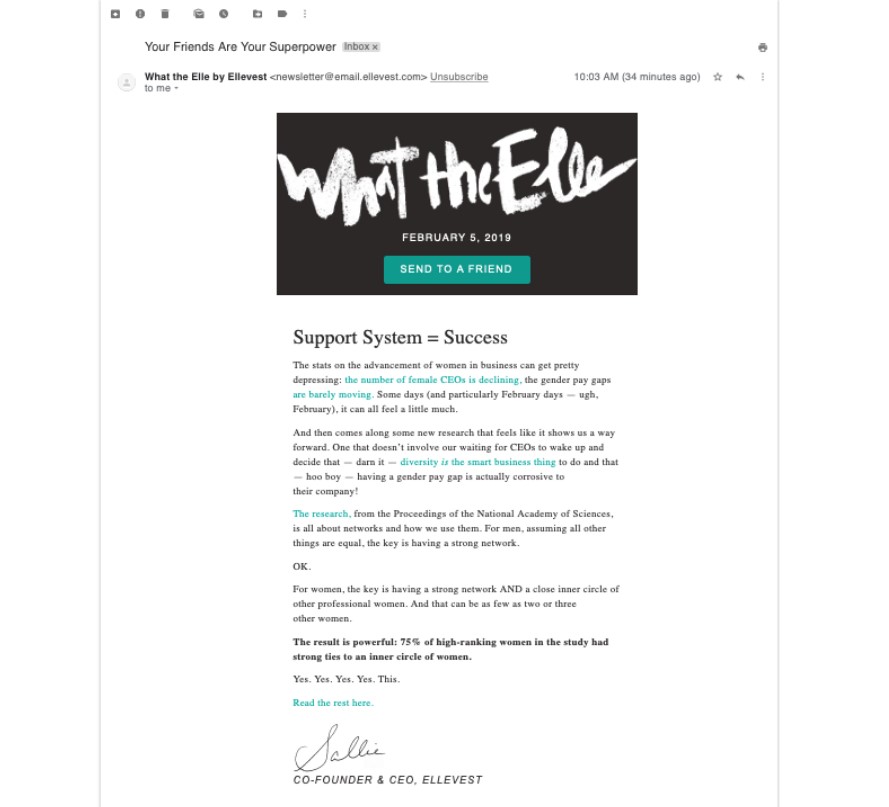Email Marketing for Financial Advisors: Examples and Strategies to Get Started
You can notice how the emerging fintech industry is rapidly bringing huge innovations to the table.
To keep up with the competition, financial services providers are upgrading their communication and email game to remain relevant.
You have probably seen how other industries are doing so well with email marketing. And you are wondering, “Can email marketing for financial advisors be that successful too?”
Our answer is YES!
Why should financial advisors use email marketing?
Many studies show that the most effective financial advisors “touch” their clients 12-18 times per year. This practice keeps the advisor at the forefront of clients’ minds, so they’re more likely to mention the advisor when a referral opportunity arrives.
It also helps improve client satisfaction and boost client awareness of other services that advisors offer, resulting in increased business. But who has time to call or meet each client more than once a month?
That’s where email marketing comes into play.
An email newsletter can touch and educate clients and is easily forwardable to referrals. To be more specific, an email marketing strategy for financial advisors can:
- Manage client data
- Keep consistent communication
- Help clients access their financial information
- Personalize client experiences
- Secure your clients’ financial activities
If you are not sending a monthly newsletter to all of your clients, prospects, and partners, it is time to get started.
Elements of a successful newsletter campaign
Before we dive into some typical examples, let’s go over a few basics. There are several things every newsletter needs to nail to be successful. Below are some of the essentials:
-
Subject lines. Your email subject line is like the movie trailer to the content. If it isn’t spot on, there is no chance your newsletter will even be opened!
-
Write content that connects. If you can, try to add personal touches, such as recipients’ names, to make them feel valued. It is essential to humanize your business with an authentic voice.
-
Visual interest. Who wants to read anything without images these days? Without engaging, relevant images and graphics, your email will put potential clients to sleep.
-
Responsive design. Most emails are read on the phone. Everything needs optimizing for mobile nowadays, and your emails are no exception.
-
Keep it short and sweet. If it feels like your email is dragging on, there is nothing stopping your reader from clicking away. For those to get value from your content, they have to read it, which will not happen if it looks like a textbook.
-
CTA. What is the point of your email? How does your audience benefit from reading it? If you are taking up potential clients’ tome, there’s got to be a straightforward point to it. Put it in plain sight with a clear CTA.
3 examples of email marketing for financial advisors
In this section, we’ll analyze 3 typical examples of email marketing for financial advisors based on the above elements. We hope you can learn something useful for your next financial email marketing campaigns.
#1. Myra Wealth
Let’s take a look at this New Year email campaign from Myra Wealth. It hits almost every element on our above list.

-
Subject line. Asking questions in your email subject line is one of the best ways to draw attention to your email. By asking a relevant question, recipients are forced to think about themselves and their behavior. Imagine if you received this email, wouldn’t you stop and think about your goals for 2019? Getting them to connect can make them more likely to want to see what’s inside.
-
Connect with their clients. The New Year, or any holiday, is a great and natural time to interact with potential clients. Making them feel like you really care about them and their resolutions can be a good start to a beautiful relationship.
-
Visuals. Every aspect of this email is visually appealing. The numbers and graphics actually help steer the eye and keep the recipient engaged. Myra even figured out a clear way to include videos at the end, which is a huge plus for any content.
-
Keep it short and sweet. Myra does an excellent job of splitting up important information with headlines. The more you can use numbers and bullets, the better. This helps the audience navigate the information without feeling overwhelmed.
-
CTA. Myra includes an obvious CTA at the bottom of the newsletter. After thoroughly walking through a financial checklist for the new year, Myra presents its offers by asking if the audience is ready to make their financial resolutions into a reality. They even include “Call us Today” in order to make the next step even more straightforward.
#2. Ellevest
Next, this email campaign from Ellevest will stand out to any lead.

You can see the full email right here.
-
Subject line. What does “Your friends are your superpower” mean? This email subject line stands out by surprising the recipient. There is instant intrigue in unexpected things. If you can stun your audience right off the bat, they will be more likely to engage with your content.
-
Connect with their clients. Adding a personal picture and the featured “elle raiser” as well as the co-founder’s signature help make the newsletter more thoughtful and authentic.
-
Visuals. Ellevest includes relevant graphics and pictures to keep the subscriber interested. As you can see, the pictures really pull your eye towards important parts of the newsletter.
-
Keep it short and sweet. Although this newsletter contains a lot of information, it is split up into bite-size pieces with the use of headings. By doing so, if a reader were to skim through quickly, an interesting header could convince them to read more.
-
CTA. One of the main goals of any newsletter is to effectively drip on prospects in your pipeline. Building strong relationships with strangers online is not an easy task, but sharing content that connects with them is an excellent way to start. Asking recipients to “send to a friend” will help you connect with even more people!
#3. Evergreen Wealth Management
Last but not least, this email promoting Evergreen Wealth Management’s case study is short, sweet, and professional. Looking at it gives you faith that you don’t need a background in design to send a well-done email campaign. Give it a scroll, and we will dissect the best part.

-
Subject line. The email subject line sucks the recipient in by making them curious for more information. By teasing something of value in the email subject line, the audience is left wanting more. Including a “case study” also promises something of value that they won’t want to miss out on.
-
Connect with their clients. By using a team photo, this makes the content more authentic. Email marketing is all about creating relationships, so any humanized touch can help make it feel more natural.
-
Visuals. Evergreen took a different approach by using relevant stock photos. If you choose this route, make sure that your pictures are related to the content and add value to it.
-
Keep it short and sweet. This newsletter provides just enough information to get the audience hooked, but not so much that they will not check out the actual case study. By including a summary, readers are left on a cliffhanger and will have no other choice but to click on the link!
-
CTA. The point of this newsletter is to get potential clients to read case studies from Evergreen, made obvious by the green “Read More” CTA button. By emphasizing the link to the case studies, this gives readers an extra nudge.
8 email marketing strategies for financial advisors
For a financial advisor, building a successful email marketing campaign is exceptionally vital for reaching out to people who are really interested in your business.
We’ve listed out some of the best strategies for you to follow. Check them out!
1. Build your email list
The good news is that you have many options at your disposal to build an email list. Some of them include:
#1. Email capture form and a lead magnet
One of the most popular ways to add more email addresses is to ask visitors to sign up for your email list.
If you would like to use this strategy, you must keep in mind that your visitor doesn’t suffer from an email shortage. An average office worker receives up to 120 emails per day, so you need to offer your potential clients a compelling reason to give their email addresses.
You might offer a lead magnet - something of value - to your audience to exchange for their email addresses. It could be a free checklist, an ebook, a white paper, a quiz, or an infographic. The key is to ensure that your lead magnet is relevant, compelling, and valuable for your audience.
#2. Blog and a sign-up form
If you have a financial blog on your website, you have the option of promoting your visitors to sign up so that they don’t miss an update. This strategy requires you to commit to a regular blog publishing schedule, since delivering on your promise of new blog posts is an essential part of building trust with your prospects.
However, that frequency doesn’t need to be exceptionally high. If you could comfortably commit to one blog post each month, that’s fine. Feeling like you actually have more bandwidth to publish twice a month? Great! The key is to choose a frequency that you’ll be able to sustain for a long time.
#3. Business cards and other branded materials
This is actually another often overlooked strategy.
Include a mention of your newsletter or blog on your business card, or in other materials (like a brochure or leave-behind). That way, potential clients can opt into your email list if they encounter you offline. Just be sure that the sign-up form on your website is optimized and properly placed.
Read more: How to Build an Email List from Scratch Fastest?
2. Segment your subscribers
When building your email list, focus on the quality of your contacts, not the quantity. To generate a more personalized customer experience, segment your subscribers to make sure everyone receives the most relevant content.

How and why you segment your subscribers is up to you, just be sure that you take the time to frequently sort through your lists in order to keep them clear of inactive subscribers.
For example, if you’ve got potential clients who are just starting to check out your business, you can use email marketing campaigns to share relevant information and position yourself as a thought leader in the financial services field.
Or, if you’ve got loyal subscribers that are already familiar with your business, you can email marketing to target your messaging and reflect the value of your offerings, advertise new services, as well as market discounts whenever possible.
Put these different groups of clients into the right lists so that your message for them is suitable for the stage of the buyer’s journey they are in.
3. Create a compelling subject line
Deceptive subject lines only leave your audience frustrated with your brand and offerings. Therefore, to avoid leaving them with a bad taste in their mouths, never give in to the temptation to write clickbait.
Be straightforward and personable with your email subject lines, while personalizing when you can for the best results (but you should go above and beyond the generic “Hi [FIRST NAME]!” greetings).
Subject lines are not a good place for using clever wording unless the meaning of the wordplay is explicitly clear. Thus, write with a focus on precision and clarity, and devote a significant amount of time to your subject line to get it up to par.
Some useful tips for creating a powerful subject line include:
- Keep it short and sweet
- Try A/B testing to know which one performs the best
- Make sure you personalize your subject line
- Avoid certain catchphrases, like “free,” “sale”
- Make sure the topic of your email is clear and specific
Related posts:
4. Format your emails correctly
By keeping your emails branded with fonts, colors, and content that fit logically with your established brand guidelines, you can establish trust with your audience and give them a feeling of consistency. When they open your emails, they immediately know what to expect and what the content should look like.
To make it easy on yourself, consider creating an email template to use and reuse, so that you don’t need to start from scratch each time you sit down to send a message for your recipients.
5. Make sure your emails correctly render on all devices
Another strategy includes formatting your emails for each type of device to help improve your readthrough and open rates.

Test your emails in order to see what they look like on desktops as well as mobile phones and tablets to make sure that you’re not overlooking a critical formatting error that can detract from your messaging. Also, when formatting for each type of device, include white space as well as bulleted lists, so your emails don’t contain a suffocating wall of text.
6. Analyze your results
It’s crucial to analyze your results regularly to determine the effectiveness of your email marketing campaign.
You can do this by reviewing your CTR (click-through rate), bounce rate, open rate, etc. By continually studying the result and improving your strategies, you can achieve significant results over time.
7. Send yourself a test email
Once you’ve created an email for your campaign, always make sure to send yourself a test version. This will help you proofread and ensure that everything works as planned.
A test email also helps ascertain whether your subject line is catching enough to incite a response.
8. Never buy an email list
This is something that many companies take very lightly until they get a severe setback. The main reason why you should never buy an email list is that you won’t gain any value from your transaction.
It’s probable that the people who receive your email have never heard of your companies, and the chances are high that your emails will be marked as spam.
For a successful email marketing campaign, it’s better to send emails to those who willingly opt to receive your emails or are at least interested in the services your company is offering.
Use AVADA Email Marketing to strengthen your email campaign
In the last section of this post, we’ll introduce an awesome platform to strengthen your email marketing campaign - AVADA Email Marketing. By using this tool, you can save a huge amount of time and focus on other important aspects of your financial business.
AVADA Email Marketing is an all-in-one automation marketing tool that receives a 5-star rating on Shopify and many positive reviews. The platform offers a number of excellent features, such as:
-
Automation workflows. Premade automation emails series help you follow up with your subscribers at any touchpoint. You can reach, engage, and convert them into your clients and raving fans. The platform supports welcome emails, win-back emails, and so on.
-
Email campaigns. With stunning pre-built templates, you can start your newsletter campaigns in a few minutes with a simple drag-and-drop editor!
-
Segmentation. AVADA Email Marketing helps you send the right messages to the right audience at the right time with advanced segmentation.
-
Forms. You can easily collect emails from visitors in different forms, such as newsletter popup, spin to win, inline form, etc.
-
Amazing training and support. The AVADA team is well-known for their friendly, knowledgeable, and professional help. Plus, you can also access a number of useful blog posts and training tutorials on the website.
AVADA Email Marketing offers a free plan, so you can test it out before deciding on the next plan!
TRY AVADA EMAIL MARKETING FOR FREE
The bottom line
Email marketing scores high when compared to other types of marketing because it’s cheap and highly effective. As a financial advisor, you should define clearly what kind of relationship you wish to have with your clients. And think deeply about what you plan to achieve.
Don’t forget to use the strategies mentioned in this blog post to convert your boring finance email into a healthy customer relationship.
Thanks for your reading, and good luck on your next email campaign!
New Posts






